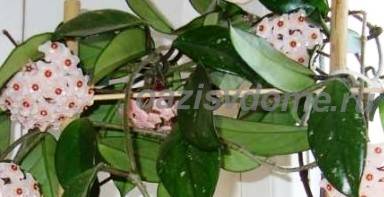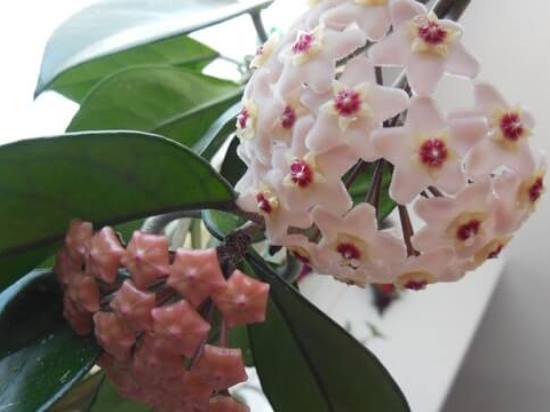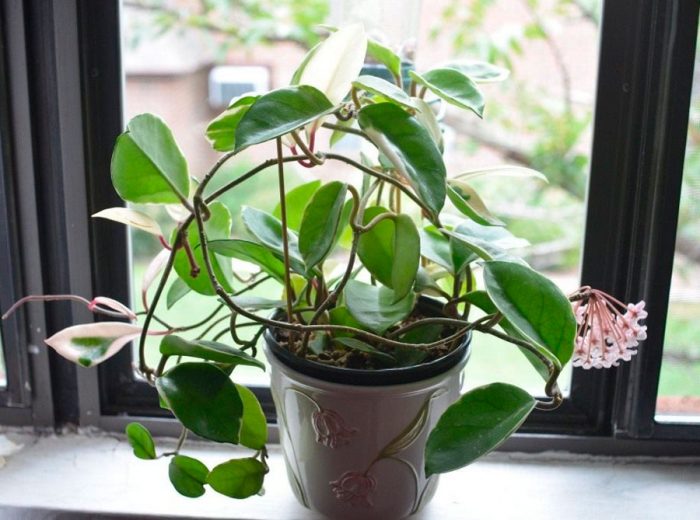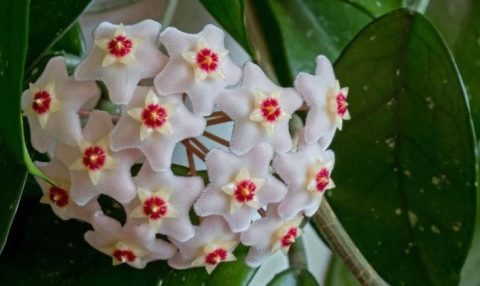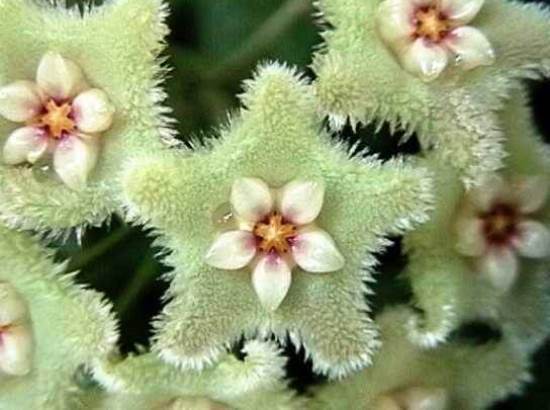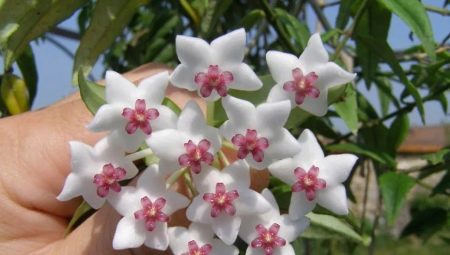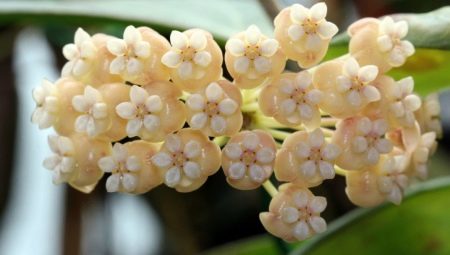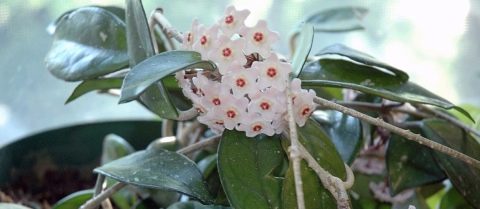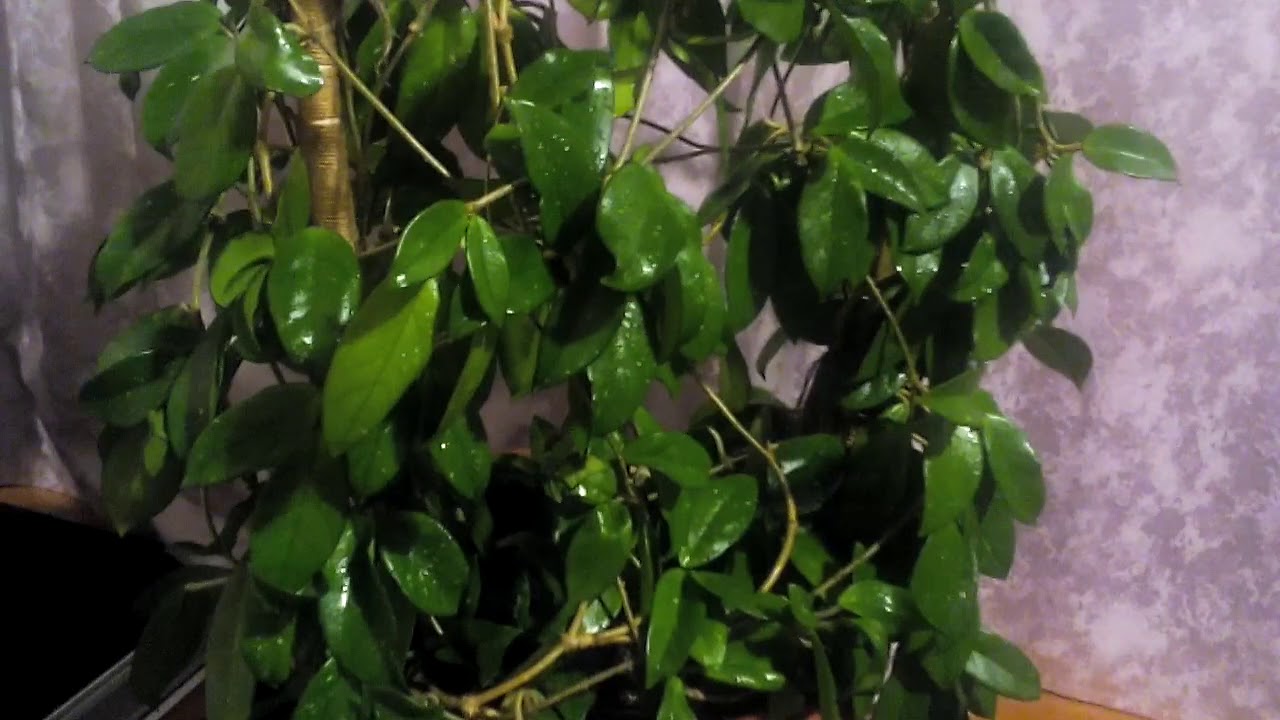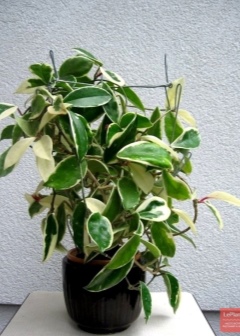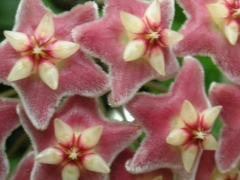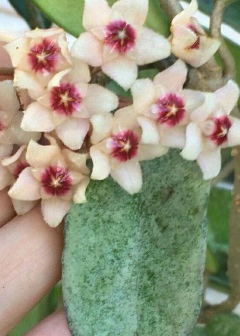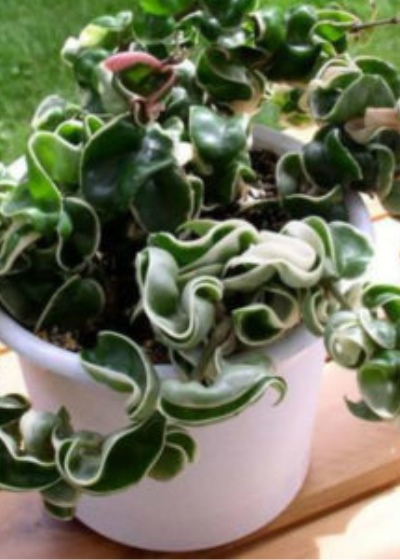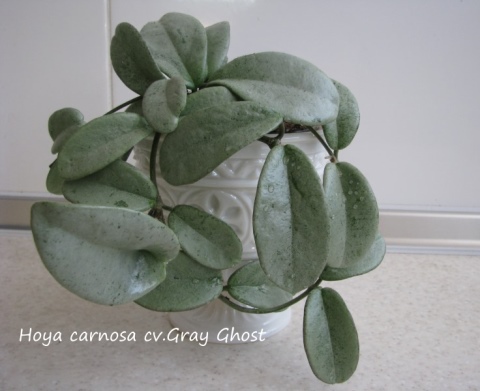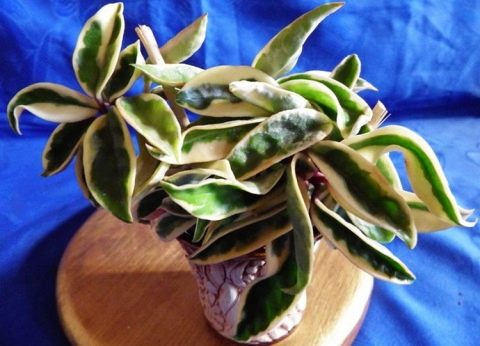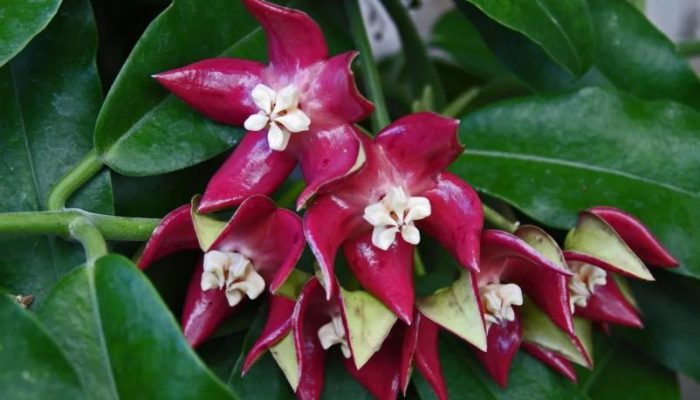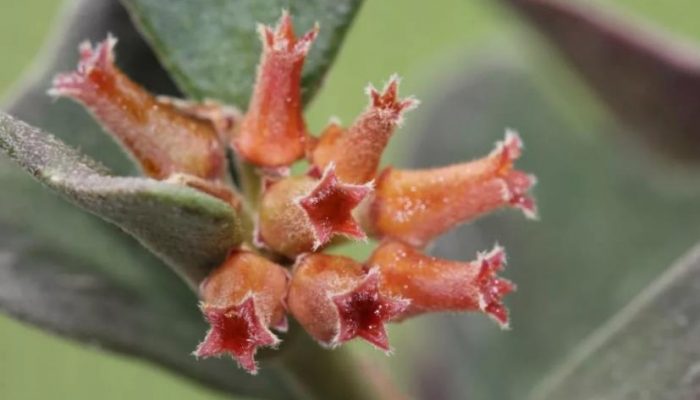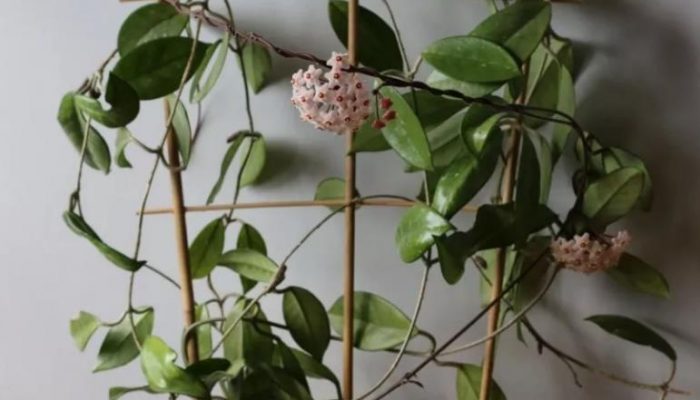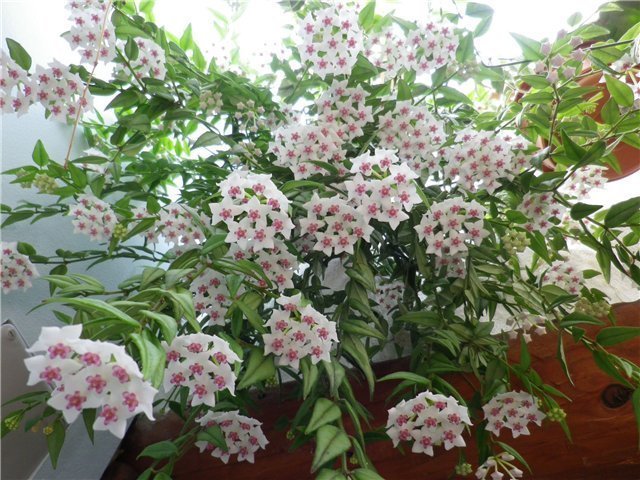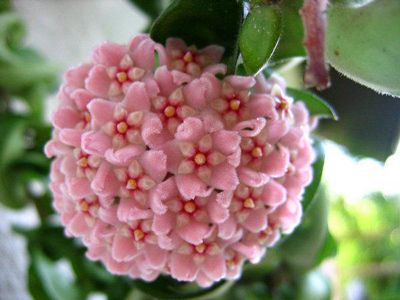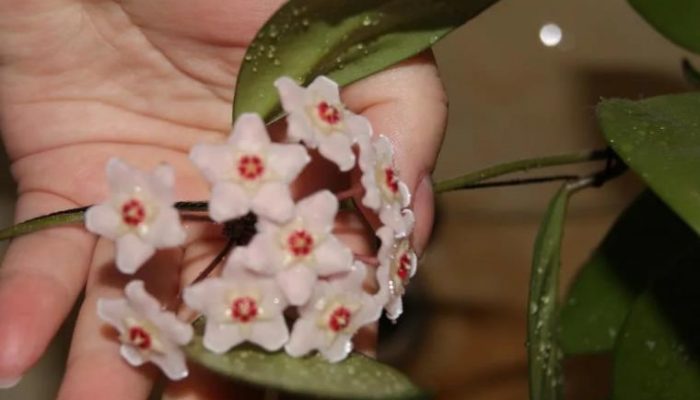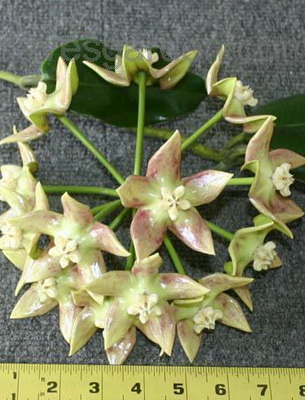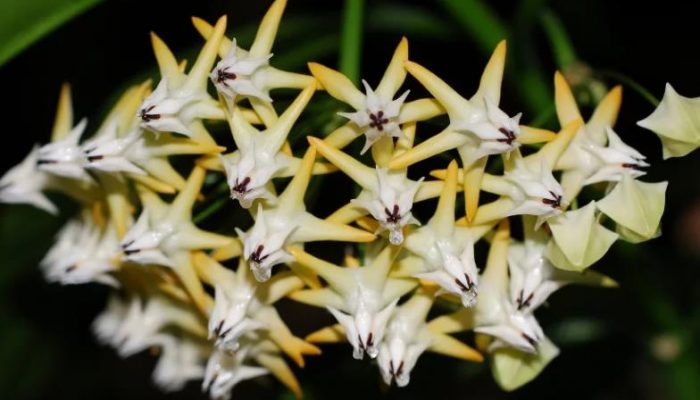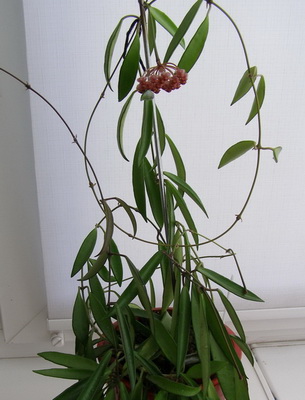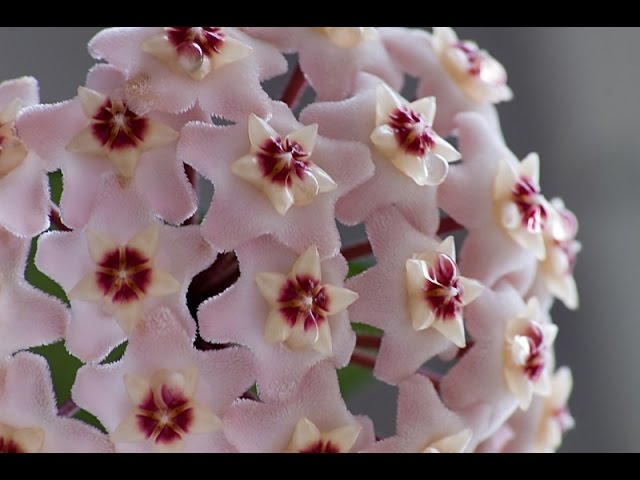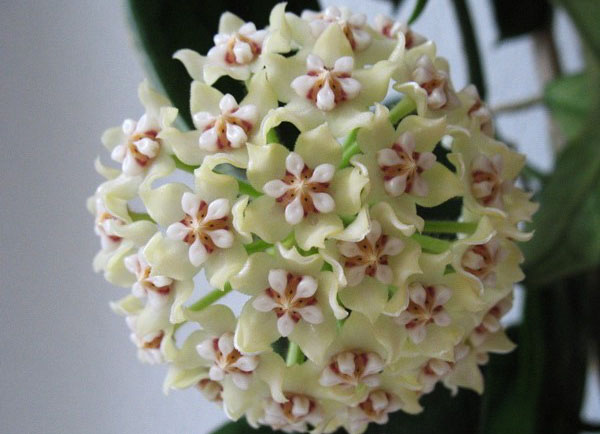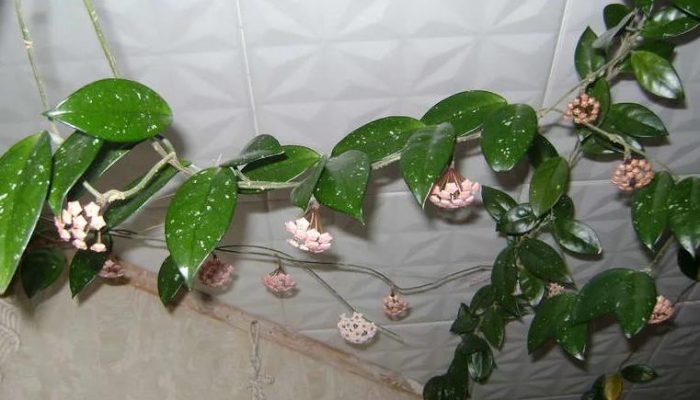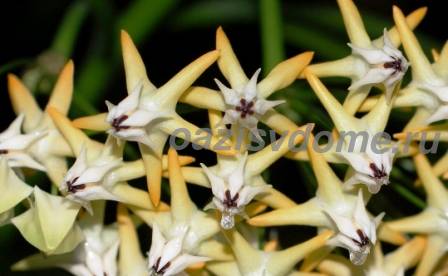Diseases and pests
Hoya, living in favorable conditions, is very resistant to both diseases and pests. But with improper care, scale insects, mealybugs and the ubiquitous red spider mites can start on the plant. You can get rid of them with the help of appropriate chemicals. It is necessary to process each lash separately and very carefully, since it is rather difficult due to the curved leaves. Some products allow spillage and soil, as pests can be in the ground. Follow exactly the instructions that come with the chemicals.
Among the possible diseases of the hoya is the root nematode. To prevent its occurrence, the soil must be disinfected before use, for example by steaming.
Due to its unpretentiousness and spectacular appearance, the Hoya compact will be an excellent decoration for any room. Her whimsical flowering garland creepers will enliven both home and office interiors.
Hoya home care rules
Each hoya, depending on the species, requires its own conditions for keeping. Common to all types of wax ivy is the control of soil moisture. The formation of dirt in the pot has a detrimental effect on any hoya, even the most unpretentious one.
Florists conditionally divide hoyi into categories according to moisture consumption and need for light:
- hoya with hard leaves, like succulents - fleshy and hoya kerry. A great location for these flowers is a south window, where there is plenty of sunshine. Watering is done as the soil dries up;
- plant varieties with thin leaves (for example, multiflorous hoya) love moist soil and cannot stand direct sunlight. They need shading and location on the west or east window;
- hoya with pubescent leaves of a light green color (linear hoya, de Serain, etc.), grow well in moist soil with a sufficient amount of sunlight;
- hoya with pubescent leaves of a dark green color (serpentine and Thompson's hoya), prefer shaded areas of the windowsill and require regular watering.
For your information! For all species, the optimal temperature is the range in summer from 15 ° C to 25 ° C, and in winter from 15 ° C. Some plants tolerate well up to 10 ° C. Otherwise, it is necessary to additionally warm up the air in the room. It is not worth experimenting, since, for example, Bella's hoya can lose leaves from the cold.
Hoya Compact
Plants growing at home do not fall into a pronounced dormant period. You can notice that the plant is in a semi-dormant state by slowing down its growth. During this period, it is recommended to abandon feeding and reduce the number of waterings. The plant should rest. The period of incomplete rest occurs in indoor flowers with a decrease in daylight hours. Turning on the lighting in the evening, respectively, prolonging the daylight hours will shorten the rest period.
Fertilization and plant transplant
In nature, there are about two hundred species. They all require different types of fertilizers, as they grow in different regions in the wild. Experienced growers have found that succulent fertilizer is the best fertilizer for all types of wax ivy. Hoyis also respond well when they are regularly transplanted into fresh soil. At the same time, top dressing is not applied so often.
It is recommended to replant young plants every year in the spring. The grown-ups require a transplant once every 2-3 years, if necessary. Hoyi do not require large pots to grow
But it is important to remember that with each transplant, the plant needs a new container, and not after other flowers.
The selected soil mixture for indoor liana must be sterilized. Choose a mixture for transplanting with good air permeability, having a neutral or slightly acidic pH.
Excellent composition - humus, leafy earth in equal parts and twice as much clay-sod soil. Some varieties thrive in orchid substrates.
Drainage is laid at the bottom of the pot, and the transplant is carried out by the transshipment method (without destroying the earthen coma).
Note! Hoya propagation occurs in the spring by cuttings
Pests and diseases
In the wild, wax ivy is highly resistant to various pests and diseases. But at home, with poor care, the hoya can be affected by a scabbard, aphids or a spider mite. For pest control, special insecticides are used.
Prevention of nematode development in a plant pot is achieved by sterilizing the soil before transplanting.
Growing
Seeds
It is almost impossible to grow Hoya Publicalix in apartment conditions, the flower, in most cases, does not produce seed pods.
In greenhouses, the variety is grown by seed in this way:
- The seeds are dried.
- Artificial fabrics, burlap are added to the substrate.
- Seeds germinate within a week.
- Gentle watering is required, treatment with fungicides of the soil.
- Seedlings should be kept in a warm, well-lit place.
- In planting containers, seedlings are kept for 2.5 - 3 months.
- When 3-4 leaves appear, young shoots are transplanted into separate pots for growing.
Seed germination is high - up to 85%, subject to their viability - the seeds lose their qualities within 1 year.
Sheet
Hoya Publicalix is grown from a leaf, but the likelihood of the desired result is low. The process is lengthy, requiring the fulfillment of the following conditions:
- It is advisable to use the leaves of natural parent varieties for reproduction.
- Use additional chemical rooting agents.
- The petiole must be kept on the leaf.
- The treated leaves are planted in a loose substrate at an inclination of 45 °.
Important: the substrate should contain a drainage layer for lightness and looseness.
Cuttings
Hoya Publicalix reproduces mainly by cuttings - the simplest and most reliable way of growing in an apartment. The procedure is simple, not laborious:
- Cut short cuttings 4 - 5 cm, which have leaves and nodules.
- The pot is wrapped in foil or dense material - no light should enter during germination.
- The cuttings are treated with root growth hormone.
- Seedlings descend vertically, 1 leaf and nodules should be in the water.
- The pot is transferred to a warm place.
- Air and water temperature - 22 - 24 ° С.
- You can cover the seedlings with foil for a greenhouse effect.
- After 12 to 15 days, the cuttings will release roots.
Do not overexpose the cuttings in water. Long, overgrown roots take root less well in the soil and break when planting.
You can simply put the cuttings in a dark container, put them in a warm place, and spray abundantly every day. The roots germinate rather quickly.
Before planting, treat the pot with disinfectants or pour over with boiling water.
Substrate for planting Hoya Publicix:
- Sod land - 2 hours
- Peat - 4 tsp
- Sand - 1 tsp
- Drainage - a mixture of sand, expanded clay and crushed stone.
Wax ivy is also called Hoya. This evergreen vine is used as an ampelous plant to decorate offices, houses and greenhouses. If you want to decorate your territory with such an unusual plant, then first familiarize yourself with all the properties and features of such varieties: Lacunosa, Matilda, Compact, Macrophylla, Retusa, Crimson Queen, Gracilis, Multiflora, Obovata and Vayety.
Description of varieties
The evergreen liana, which is known as fleshy hoya, or waxy ivy, has a well-developed root system and a branched stem up to 10 m long, covered with tough, pointed leaves. Flowering, in which fragrant flowers of various colors, collected in umbellate inflorescences, bloom, occurs in the summer.
Breeders have bred many varieties of hoya carnose, which differ in shape, color of leaf plates and flowers.
Among the most common and original representatives of the type species are:
- Variegata - a form with pink flowers bordered by a white stripe;
- Exotica - a distinctive feature of the variety is the yellow color of the leaf plates, gradually acquiring a green tint towards the edges;
- Tricolor is a variety with green-edged leaf blades that change the base color from red to yellow as they mature;
- "Crimson Queen" - the variety stands out with rich pink flowers with a more delicate border around the edges.
Home care
Despite the exotic nature, the houseplant hoya carnosa is not capricious, so caring for it will not give a florist any trouble.
Soil composition and pot selection
When choosing a pot for a vine, it must be remembered that the hoya will not bloom until its roots are completely braided with an earthen ball.
For this reason, preference should be given to small but tall pots or pots if the florist plans to grow the plant in the form of an ampelous plant.
A properly selected container is filled with a loose, nutritious soil, which can be made independently from leafy, soddy soil, humus, sand in a ratio of 3: 2: 2: 1.
It should be baked in the oven to kill infection and insect larvae. Also, the substrate can be purchased at the store, opting for potting soil for palm trees.
Watering Hoya Karnosa
Watering an exotic flower should be moderate after the earthy clod dries out to the depth of the phalanx of the finger. In the summer, weekly watering is enough for the liana.
With the onset of winter, when the culture is kept in a room with a low temperature regime, the culture will need to be moistened only once every 2 to 3 weeks. Water procedures are carried out with settled water. In this case, it is necessary to ensure that water does not remain in the sump, which can lead to the development of gray rot.
Fertilization
Hoya carnosa flower needs additional nutrition only in the summer, every 2 weeks. For top dressing, liquid mineral fertilizers are used for flowering plants with a high phosphorus content.
Planting and transplanting
The plant painfully tolerates transplants, therefore, having acquired a flower, you should give it time to acclimate, and then carefully transplant it from the shipping container into a pots of a similar diameter. A drainage layer must be placed on the bottom of the permanent container
After planting, the hoya is not watered, but only sprayed
A drainage layer must be placed on the bottom of the permanent container. After planting, the hoya is not watered, but only sprayed.
Subsequently, the transplant is carried out after 2 - 3 years, when the roots appear from the drainage holes, demonstrating that the pot has become too tight.
Pruning
The flower does not need pruning, as new inflorescences appear on the old arrow. For sanitary purposes, only damaged leaves can be removed with a sterile instrument.
Breeding features
At home, hoya propagates by cuttings. The apical cuttings are cut 10-15 cm long so that they have 2 internodes. Hoya takes root both in water and in a wet substrate of peat and sand. If you create greenhouse conditions for the cutting by covering it with a plastic cap, the rooting process will accelerate.
Plant diseases and pests
Like other succulents, the vine can be attacked by the whitefly, spider mite, mealybug and scabbard.
To quickly and effectively deal with the emerging pests, you should resort to spraying with an insecticidal preparation according to the manufacturer's instructions.
The plant is not susceptible to diseases, however, with stagnant water in the roots or with systematic waterlogging of the soil, the development of gray rot is possible. In order to prevent the disease of the graceful vine, the irrigation regime should be strictly observed.
1. Seven Secrets of Success:
| 1. Growing temperature: storage of bulbs at a temperature of about 5 ° C, after planting and before the formation of leaves, plants are kept at a temperature of 10 - 12 ° C, with the appearance of a peduncle, the temperature of the content is raised to 16 - 18 ° C. A higher air temperature greatly reduces the time flowering. |
| 2. Lighting: long daylight hours with light shading from direct sun during daytime hours in spring and summer. |
| 3. Watering and air humidity: during the period of growth and budding between waterings, dry the soil to a depth of about 3 cm. It is better to increase the air humidity. |
| 4. Pruning: after flowering, formative pruning is carried out, if necessary - sanitary, peduncles with fading buds are promptly removed. Pinch the tips of young stems. |
| 5. Substrate: well-drained, nutritious, loose, neutral or slightly acidic substrate. |
| 6. Top dressing: during the period of growth and formation of buds, the plants begin to be fed every 2 weeks with organic or mineral fertilizers. Hoya is left without fertilizer during the winter months. |
| 7. Reproduction: hoya propagates by rooting stem and leaf cuttings in spring and summer, by air layers, seeds. |
Botanical name: Hoya.
Hoya flower - family
Homeland of the plant. East and Southeast Asia, Australia.
Description. Hoya or wax ivy is a perennial, evergreen plant with curly, thin, long shoots.
Leaves are green, fleshy, simple, glossy, elliptical, bent along the central vein.
Rounded inflorescences are formed on shoots 2.5 - 6 cm long and consist of many attractive flowers up to 1.5 cm in diameter.
The color scheme of the plant is very diverse and includes white, pale pink, orange, yellow, burgundy, purple and even almost black shades.
Hoya bloom fills the house with an enchanting scent, especially in the evening.
Variegated varieties delight the eye not only with attractive inflorescences, but also with leaves that have yellow and white spots.
Height. The stems of the hoya room reach a length of 3 m, the flower grows quickly and in one season the stems can add up to 30 - 50 cm in length.
Diseases and pests
Like any other plant, hoya suffers from various diseases and pests. In the event of fungal diseases, it is necessary to treat the leaf plate with a solution of copper sulfate. Abundant watering can provoke rotting of the root system, as well as the formation of mold on the surface of the soil. The most dangerous pests of the vine are thrips, scale insects and root nematodes. Signs of damage to a flower by pests:
- the formation of brown and white spots;
- yellowing and drying of leaves;
- the formation of cones on the leaf plate and stems;
- cessation of plant growth and development.
Plants affected by insects must be treated with special chemicals. Before processing, you must carefully read the instructions and use personal protective equipment. To prevent the appearance of pests, it is necessary to regularly bathe the flower in the shower.
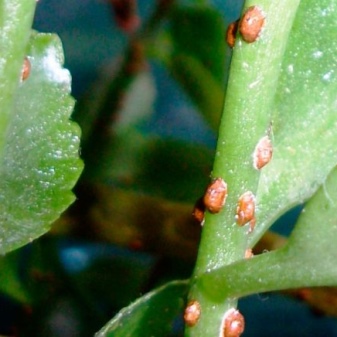
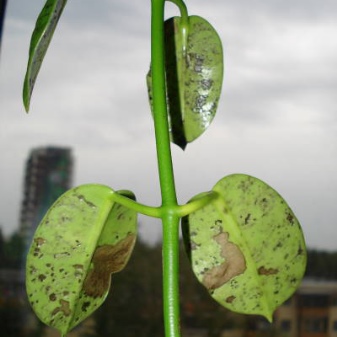
And also problems can arise if the rules of maintenance and care are violated:
- the presence of dark spots - sunburn, moistening the soil with cold water, an excess of mineral fertilizers;
- drying and curling of leaves - violation of the temperature regime;
- falling foliage - low level of humidity in the room;
- wilting buds - lack of moisture;
- dying off and rotting of shoots - boggy soil;
- slow growth and discoloration of the leaf plate - the introduction of an insufficient amount of nitrogenous fertilizers.
See the next video for even more about carnosis hoya care.
The main aspects of caring for a home vine
Hoya carnosa is quite unassuming, but it should be borne in mind that it is a succulent plant and does not suit the conditions that most leafy flowering crops like. What points should you pay special attention to?
Lighting
Hoya fleshy loves light and bright lighting is necessary for its full growth and development. It is advisable to put a pot with a liana on a window on the south side, here it will feel as comfortable as possible.
Unlike other green vegetation, cornosa is not afraid of direct sunlight. It is protected from burns by a wax coating on the sheet plates. However, in the midday heat, it is still better to shade the flower a little.
The vine can grow on the north side, but, as a rule, it does not bloom under such conditions. With a significant change in the duration of daylight hours, the succulent is able to freeze for a while.
During the budding period, it is not recommended to move the container with the plant to another place or turn it. Even minor changes will cause the vine to shed its buds.
Watering
One important rule works here - moderation. The water should be separated, at room temperature, ideally rainwater or melted ice
It is recommended to water the flower after the topsoil dries out to a depth of 2-3 cm. In summer, 2 waterings per week are enough, in winter - 3-4 times a month.
It is important to bring in enough moisture to keep the earth ball fully moist. In this case, excess water must be removed, since when overmoistened in succulents, the root system rots.
Hoya can tolerate a short drought without much loss, however, with a significant lack of water, the flower can stop growing and blooming.
Temperature regime
It depends on the season: in summer, the temperature should be moderate, not higher than +24 degrees. In winter, a decrease is necessary, ideally - +16 degrees, not lower than +10 degrees.
In the summer, you can expose the hoya pot to fresh air - on a balcony or veranda
But it is important that he does not stand in a draft, they are dangerous for this plant.
Air humidity
It is desirable that this indicator be at least 80%, because in nature, hoyi grow in humid climatic conditions. You can increase the humidity by regularly spraying the plants, but this must be done very carefully so that moisture does not get on the buds and inflorescences.
Priming
You can purchase a ready-made soil mixture designed for cacti and succulents. It is moderately light, contains the optimal amount of nutrients, breathes well and does not retain moisture - this is what succulent crops need.
But you can also do self-preparation of the soil. This will require three components, vermiculite is mixed with crushed expanded clay and peat.
To ensure high air permeability of the soil and the removal of excess moisture, you should take care of good drainage. A layer of brick chips, fine gravel or other suitable material is placed on the bottom of the container.
Pot
Hoya has a shallow root system that does not go deep into the ground, so it is better to select a shallow, wide reservoir. It can be plastic, ceramic or clay, covered with ceramic glaze - such a coating is necessary for the tightness of the walls.
A prerequisite is the presence of drainage holes in the bottom of the pot.
Fertilization
It is recommended to feed hoya in summer. If it grows in a high-quality substrate, then 1-2 events per month are enough.Before applying top dressing, it is advisable to water the flower well and apply the agent to the soil so that it does not fall on the foliage and stems.
Complex formulations in liquid form are most suitable for this succulent, which should be diluted with water before application. But top dressing containing a large amount of nitrogenous substances should not be used. In winter, the flower rests, so it does not need fertilizers.
Pruning
The pruning process should be taken seriously, since you cannot touch the flower stalks. Even if ivy has faded, its old flower stalks are not cut off, as they are able to acquire new inflorescences. Most often, flower growers remove only a part of very long shoots or even leave them intact, substituting supports for them.
Fleshy hoya is far from being a capricious flower, which not only pleases with a beautiful long flowering and sweet aroma, but also has a beneficial effect on the atmosphere of the home, cleans the air of harmful compounds.
Liana is grown not only indoors, but also outdoors: how to care for the street hoya kprnosa?
Description
Hoya kerry is a native of Polynesia and comes from the classic vine. Characteristic features of the plant:
- heart-shaped leaf;
- tall shoots requiring support;
- green foliage, however variegated subspecies are also found;
- leaves are dense, juicy, fleshy, not sinewy;
- the minimum sheet size is 5 cm, the maximum is 15 cm;
- flowering can be of various shades: red, white, pink and even yellow;
- the brighter the light, the richer the shade of the inflorescence;
- an umbrella-type inflorescence, up to 2 cm in size;
- flowering has a pronounced aroma;
- mature plants release nectar.
Growing Difficulties: Mistakes That Lead to Disease
Hoya, kept in suitable conditions and receiving proper care, usually do not get sick. Only weakened specimens are prone to ailments and are not able to withstand pests:
- With a lack of water, a mealbug may start on the flower - the first sign of infection, the appearance of a whitish bloom. You can remove it by treating the foliage with soapy water and increasing the humidity in the room.
- In the heat, when the air is too dry, and the temperature is high, a spider mite can start on the hoya, entangling the flower with a thin cobweb. This "guest" is taken out in the same way as the previous one, with the obligatory correction of the microclimate.
- Excessive waterlogging of the soil leads to the development of root rot. Often this turns out to be the cause of the death of the vines, since the external signs of the disease appear too late. If, nevertheless, it is possible to recognize the disease at an early stage, then the plant can be saved by washing the roots in water, cutting off the affected areas. They should be disinfected and hoya planted in fresh soil.


